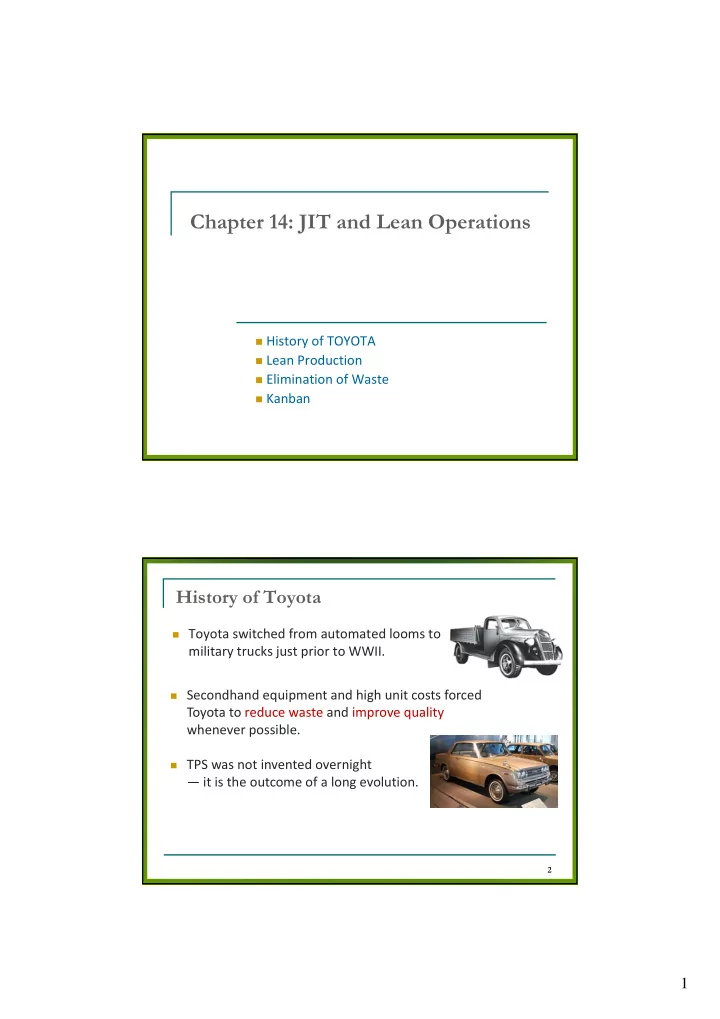

Chapter 14: JIT and Lean Operations History of TOYOTA Lean Production Elimination of Waste Kanban History of Toyota Toyota switched from automated looms to military trucks just prior to WWII. Secondhand equipment and high unit costs forced Toyota to reduce waste and improve quality whenever possible. TPS was not invented overnight — it is the outcome of a long evolution. 2 2 1
Lean Production 精實生產 Just ‐ in ‐ time : A highly coordinated production system in which materials are moved through the system with precise timing, just as they are needed. JIT ← → MRP JIT = lean production Lean operations for service systems. 3 The Toyota Approach Muda: waste and inefficiency ( 浪費 ) Heijunka: workload leveling ( 平準化 ) Kaizen: continuous improvement ( 改善 ) Jidoka: automatic detection ( 自働化 ) Poka ‐ yoke: fool ‐ proofing to reduce errors Team concept: small teams for improvement ( 品管圈 ) Kanban ( 看板 ) Pull system: supplying material based on demand 4 2
Goals and Building Blocks of JIT 5 TOYOTA Production System Elimination of Muda Inventory, Overproduction, Waiting time, Unnecessary transportation, Processing waste, Inefficient work methods, Product defects Muda: 庫存過多、生產量過多、待工待料、搬 運與包裝、產品設計過度、加工方法浪費或缺 乏效率、不良品 6 3
Heijunka (level loading) 根據實際需求安排生產計劃,使生產量與生產內容平準化 當月計劃生產 800A 、 600B 、 400C 每週生產 200A 、 150B 、 100C 每天生產 40A 、 30B 、 20C 實際現場排程 AAAABBBCC AAAABBBCC mixed model production 7 Single Minute Exchange of Dies 快速換模 faster set up smaller lot sizes smaller inventory internal setup external setup 事先調整定位、簡 易拆卸、預熱模具 8 4
Jidoka (autonomation) automatic detection of problems Kaizen : Continuous Improvement 降低庫存迫使生產線必須面對並解決各種問題 9 Kanban 看板是一種控制物料的方法,看板在物料生產過程中 提供相關資訊,包括時間、規格、數量、運送地點等 10 5
Pull System with Kanban Control 上游 6 2 4 1 P 看板 P 看板 C 看板 C 看板 市場 5 2 B B A A 7 3 前製程 後製程 運送看板 (Conveyance) :各站完成加工的產品 必須得到下游的運送看板才能前進 生產看版 (Production) :各站等待加工的產品 必須得到該站的生產看板才能進行加工 11 Single-Kanban Systems A unit cannot move to the next resource until it receives a kanban card authorized by the downstream resource. The inventory at a resource is limited by the number of kanban cards assigned to that resource. Production Production Upstream 5 3 1 Kanban Kanban Demand B B A A 2 4 Input Output Input Output 12 6
Determining the Number of Kanbans Needed DT(1+X) N = C N = Total number of kanbans D = Planned usage rate of using work center T = Average waiting time for replenishment of parts plus average production time for a container of parts X = Policy variable set by management – possible inefficiency in the system C = Capacity of a standard container 13 Conclusion Lean Production is suitable for assemble to stock, high volume and low variety production. The goal is to achieve a balanced, smooth flow of production. Key elements include quality at the source, elimination of waste, continuous improvement, setup time reduction, workload leveling, kanban control. There is more to a successful operational turnaround than the application of a set of tools. 是信仰,不是技術 Mindsets of employees must be involved in the process. 14 7
Recommend
More recommend